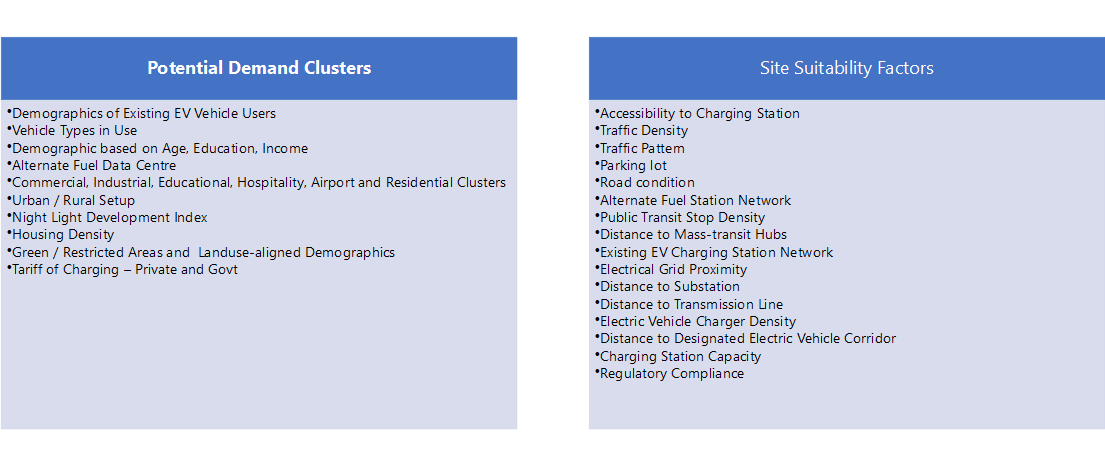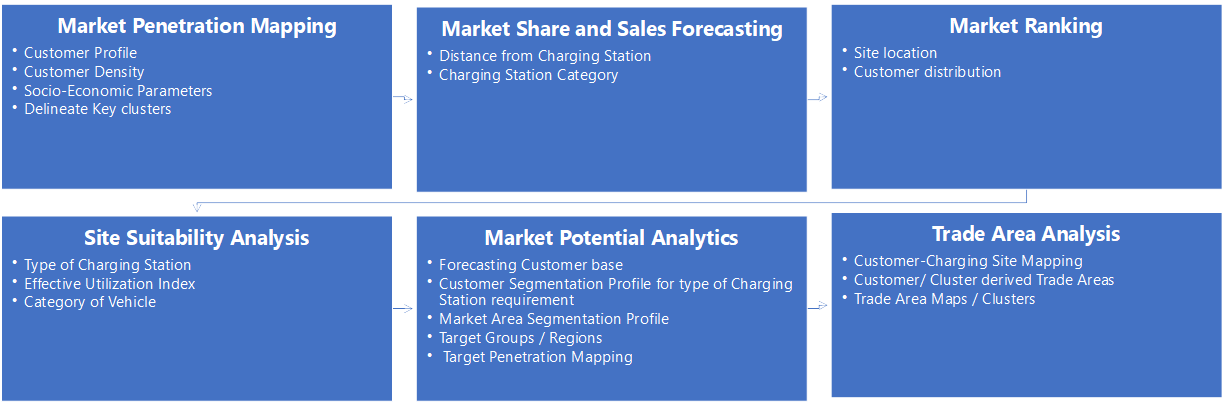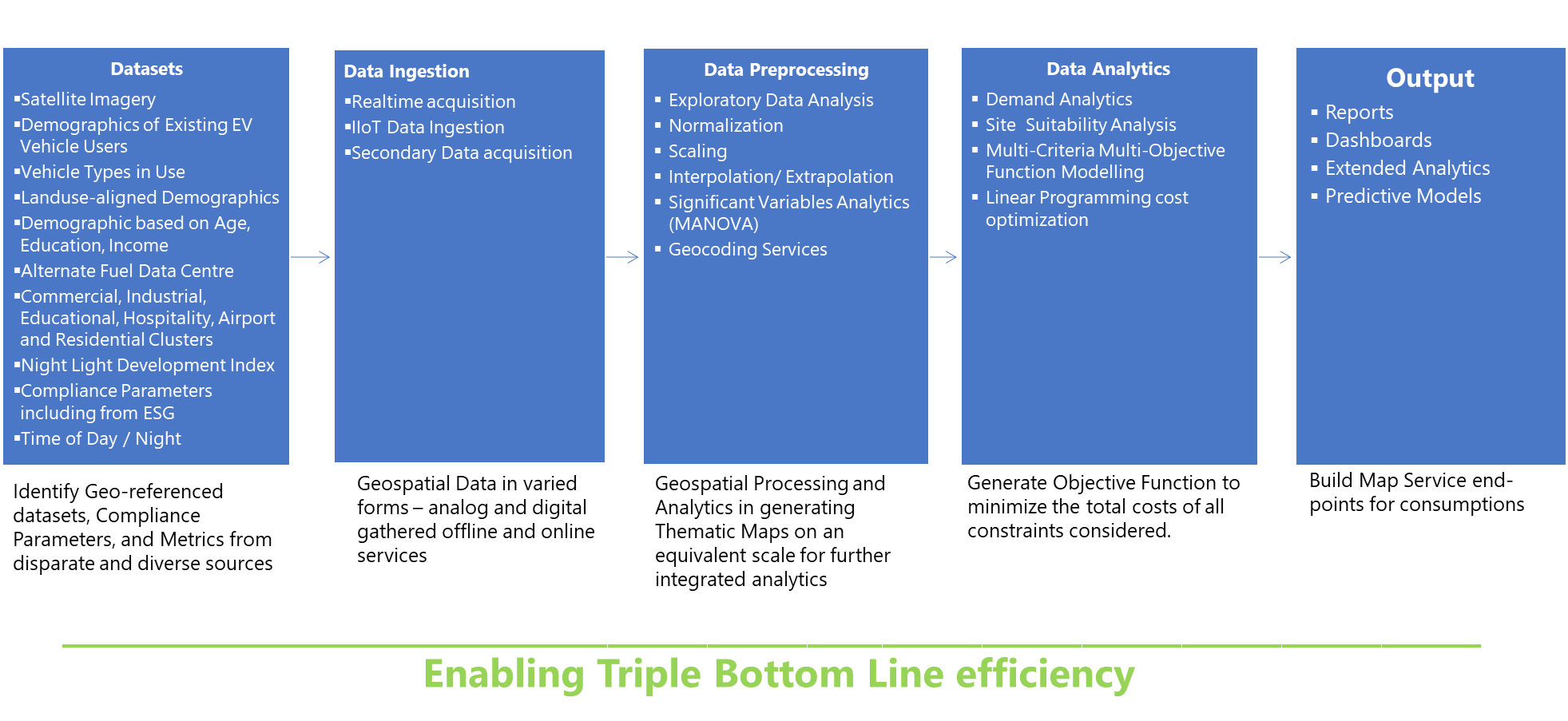Location-Analytics in Site Selection for EV Charging Stations
Written by Nihar Ranjan Sahoo 08 Jun, 2023
With global temperature rising, and greenhouse gases being emitted at an exponential rate, the need for greener technology has potentially become highly necessary. This transition to electric mobility is a promising global strategy for decarbonizing the transport sector that most countries support the global EV30@30 campaign – it targets to have at least 30% new vehicle sales be electric by 2030. McKinsey’s base-case scenario for EV adoption suggests approximately 120 million EVs could be on the road by 2030 in China, the European Union, and the United States.
An accessible and robust network of electric vehicle (EV) charging infrastructure is an essential pre-requisite to achieving this ambitious transition. Most countries have instituted various enabling policies to promote the development of the charging infrastructure network and build capacity among stakeholders to support its on-ground expansion. A contextual approach is needed to ensure the efficient and timely implementation of EV charging infrastructure, such that it meets local requirements and is optimally integrated within the electricity supply and transportation networks.
The key challenges is about non-alignment of readiness of having charging stations and the demand. Site selection to optimally deploy a Charging Stations is a complex process considering many factors like electrical service availability, cruise time, the type(s) of drivers and vehicles that the charging stations are to serve, traffic density and travel hours of the day, and land ownership, while the most critical being social equity. These diverse factors are collated and synthesized to estimate the demand and provision services with utmost utilization of the Charging Station. Basis the demand analysis, a Site Suitability Analysis can be designed to understand potential sites that provides a good coverage and high utilizations to optimize travel time for customer and hence reduces carbon footprint.
The key challenges of driving EVs are shorter mileage range and long hours of charging activities. Charging equipment varies by charging time, how much a battery holds, types of batteries, and the types of Electric Vehicle Supply Equipment (EVSE). The charging time can range from 20 minutes to 20 hours depending on the above parameters. Typically, there are 3 categories of charging stations based on the AC/ DC charging levels - AC Level 1, AC Level 2, DC Fast Charging; and their usage in Commercial and Residential establishments as - Public Access Charging, Workplace Charging and DC Fast Charging. The speed of charging and types of vehicle being charged are the constraints optimized in advising a customer to take service from a specific Charging Station.
A GIS with GeoAI and Machine Learning algorithms provides a comprehensive platform to collate and synthesize with these constraints and help in delineation of customer clusters and site suitability analysis for the charging stations and a specific category of it to suite to the right category of vehicle. It also extends the analysis to displace or replace an existing Charging Station optimized based on usage pattern and coverage. There can be a time origin-destination analysis to model spatial and temporal characteristics of EV charging loads based on the customer visit pattern.
Following are a select broad set of factors for Demand analytics and carry out Site Suitability Analysis. The list of parameters to estimate demand for each category of the Charging Station – considering variety of demographic data covering societal, kind of vehicle, tariff charges. Multivariate analysis with different algorithms including Weigh-Rank Models, Design of Experiment are attempted to identify potential demand clusters. The factors are suitably weighed and classes in each factor are ranked to build a model. Support Vector Machine and Logistic Regression techniques also provide good results in extracting the demand clusters.

The potential customer clusters identified here are used along with the site suitability analysis parameters for evaluating potential locations for siting Charging Stations. It is typically a Multi-criteria Multi-objective Decision Making that considers these above factors. The key objectives -Category of Charging Station, Optimal Distance aligned with reduced emission and Optimal Time. It also can evaluate the utilization efficiency of the existing stations while re-evaluating for new and additional sites; displacing or replacing the old sites as well. The unique characteristics of having limited cruise range, poor recharge times, and the characteristics of regaining energy during deceleration require innovative routing algorithms which is energy-efficient. These constraints listed above are considered together to extract an optimal energy efficient route. This optimized usage of electricity in turn is expected to control the production to a certain extent and hence bringing down emissions.
The results are to have
a) Mapping of Charging Station with the Customer Cluster - based on the customer category and Charging Station category and whether public or private type.
b) Vehicle type with Charging Station mapping
c) The public or private stations mapped with the Social Equity feature.
There are following six blocks of analysis carried out in provisioning end-to-end solution in EV Charging Station Suitability Analysis. It covers analytics in each category of Vehicle, Type of Charging Station and Effective Utilization Index (coverage efficiency for the customer cluster).

Execution Pipeline
The execution pipeline for the end-to-end solution is as below.

- The datasets in primary (from Ground Truth or Satellite Imagery) and Secondary are acquired either online or offline and ingested in the Pipeline.
- Pre-Processing: Each theme of data is geocoded, interpolated/extrapolated as required, normalized and scaled before they are attempted for Demand Analytics (customer clusters) and locating Suitable sites.
- The solution draws out the customer clusters based on their vehicle category, landuse cluster (residential, commercial, industrial and others) for right category of Charging Station (Public Access Charging, Workplace Charging and DC Fast Charging) on a GIS platform. Each execution starts with defining a specific objective and ends with how to use the results to identify specific potential locations that could be investigated further.
- A set of Multi-variate optimization algorithms including Huff Model and others are attempted in Multi-Criteria Multi-Objective Analysis in extracting potential Charging Station sites with the identified Customer-clusters based on the Attractive Index based on the objectives set in the model.
Conclusion
With the increasing use of electric vehicles, expansion of consumer demand for charging and increase in service requirements, it is a complex process to optimally site charging stations in the network and meeting the charging demand while complying with ESG guidelines. With the introduction of vehicle GPS and the availability of communication base station data, more and more studies are using real-time EV trajectory data and location data to generate real-time demand generation for a vehicle type, and customer profile to map with a Charging Station optimally in terms of ETA, Optimal Distance aligned with Reduced Emission and help prepare a Scheduler for Charging in real-time.
Cyient’s megatrend report covers sustainability theme that mentions intelligent- and meta-mobility, and sustainable energy and platform – electric mobility system, battery management, alternate mobility, Electric Vehicles, charging system and enhanced grid capabilities - Vehicle to Grid Technology; those that enabled in designing and implementing sustainable solutions. Site Selection optimization is expected to provide energy-efficient routing for customers of a particular category to reach right Charging Station and hence with effective and efficient usage of the already charged Battery.
About the Author
Nihar R Sahoo holds a Ph.D. in Earth Sciences specializing in GIS, Remote Sensing, and Applied Statistics. He has over 23 years of industry experience. His areas of interest are building end-to-end development, deployment, and operationalization of geospatial machine learning solutions with earth observation data.
.png?width=774&height=812&name=Master%20final%201%20(1).png)